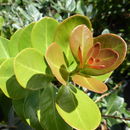Brief Summary
provided by EOL authors
Psidium cattleianum, strawberry guava (also known as cattley or cherry guava), is a shrub or small tree in the Myrtaceae (myrtle family) native to eastern Brazil and now cultivated in tropical and semi-tropical areas worldwide for its fruit and as an ornamental. It has escaped cultivation and become a serious weed in various Indian and Pacific Ocean locations, and is considered the worst invasive plant species in Hawaii. The strawberry guava is similar in flavor and uses to guava (P. guajava), but is generally smaller (although considered to be more attractive). Other guava fruits that are commercially grown are the Costa Rican guava (P. friedrichsthalianum) and the Guinea guava (P. guineense). P. cattleianum, which is sometimes classified as P. littorale, or P. cattleianum var. littorale, with “cattleyanum” as an alternative spelling often found in older literature) may be a shrub or many-branched small tree, with smooth brown bark and slender branches, which may reach heights of up to 12 m (39 ft), although typically growing to 2 to 4 m (6 to 13 ft). Some varieties are moderately frost-tolerant, and may be hardier than P. guava. The leaves are oval to elliptical, up to 4.5 cm (1.75 in) long, smooth and leathery to waxy, with prominent veins. The fragrant white flowers are tubular with 5 petals, and are larger than the leaves, to 6 cm (2.3 in) wide, and are either solitary or in clusters of 3 at the axils (where leaf meets stem). The fruits, which are produced when the plants are 3 to 6 years old, are round to somewhat oval, about the size of a walnut around 4 cm (1.5 in) long, with a thin skin that ripens to a color ranging from yellow (in var. lucidum) to dark red or purple, tipped by the remains of the calyx (somewhat like an apple or blueberry). The juicy flesh, which is white or yellow, has many soft seeds embedded in it. The fruits, which are high in vitamin C, have a pleasantly sour taste, are often eaten fresh, or may be processed into jams, jellies, and juices, as well as ice creams and sorbets. Guava purées and pastes (made from boiling the fruit with sugar and water) are used as a filling in baked goods. P. cattleianum has escaped cultivation and become a serious invader in Polynesia, Mauritius, the Seychelles, Norfolk Island, Australia, New Zealand, and various islands, as well as the U.S. states of Florida and Hawaii. It can invade even intact rainforests, and tends to grow in dense thickets (from both root suckers and seedlings) that shade and outcompete native plants. It is ranked as one of the world’s 100 worst invasive species by the International Union for the Conservation of Nature (IUCN). (Bailey et al. 1976, ISSG 2012, Morton 1987, PIER 2012, van Wyk 2005.)
Description
provided by Flora of Zimbabwe
Slender evergreen tree, native in Brazil. It is grown for its edible fruits or as a garden ornamental.
- license
- cc-by-nc
- copyright
- Mark Hyde, Bart Wursten and Petra Ballings
- bibliographic citation
- Hyde, M.A., Wursten, B.T. and Ballings, P. (2002-2014). Psidium cattleianum Sabine Flora of Zimbabwe website. Accessed 28 August 2014 at http://www.zimbabweflora.co.zw/speciesdata/species.php?species_id=142260
- author
- Mark Hyde
- author
- Bart Wursten
- author
- Petra Ballings
Frequency
provided by Flora of Zimbabwe
Rare
- license
- cc-by-nc
- copyright
- Mark Hyde, Bart Wursten and Petra Ballings
- bibliographic citation
- Hyde, M.A., Wursten, B.T. and Ballings, P. (2002-2014). Psidium cattleianum Sabine Flora of Zimbabwe website. Accessed 28 August 2014 at http://www.zimbabweflora.co.zw/speciesdata/species.php?species_id=142260
- author
- Mark Hyde
- author
- Bart Wursten
- author
- Petra Ballings
Worldwide distribution
provided by Flora of Zimbabwe
Native to S America (Brazil) and naturalised elsewhere
- license
- cc-by-nc
- copyright
- Mark Hyde, Bart Wursten and Petra Ballings
- bibliographic citation
- Hyde, M.A., Wursten, B.T. and Ballings, P. (2002-2014). Psidium cattleianum Sabine Flora of Zimbabwe website. Accessed 28 August 2014 at http://www.zimbabweflora.co.zw/speciesdata/species.php?species_id=142260
- author
- Mark Hyde
- author
- Bart Wursten
- author
- Petra Ballings

